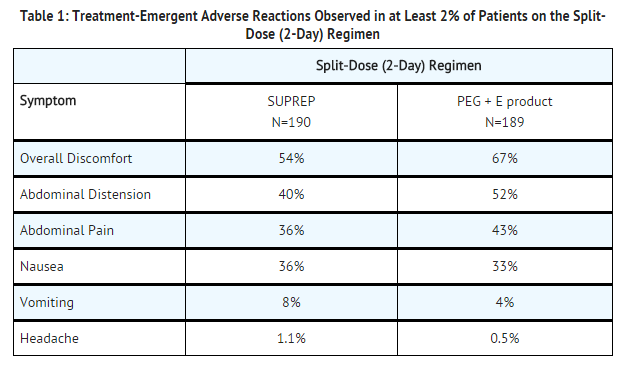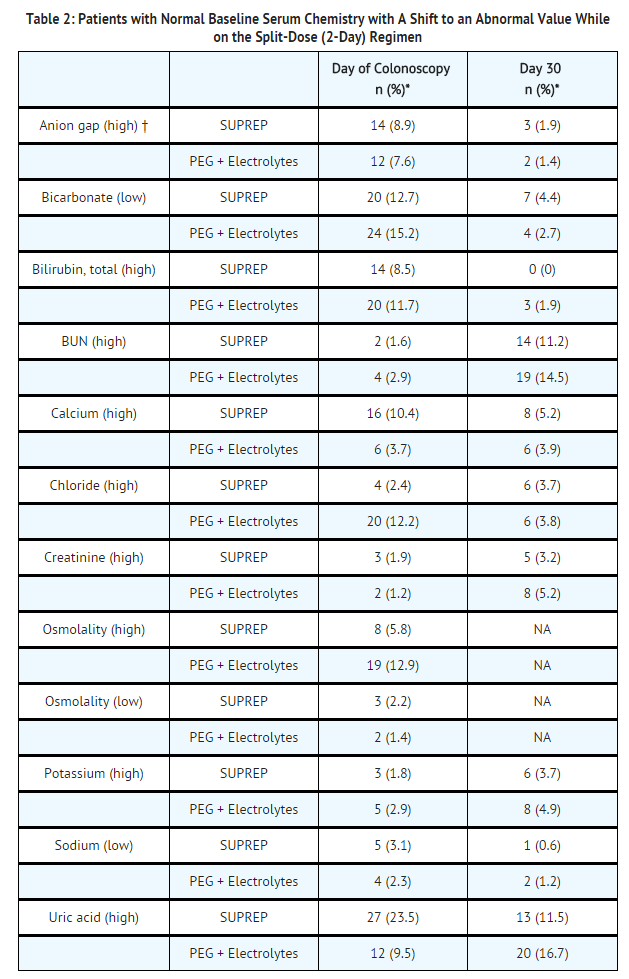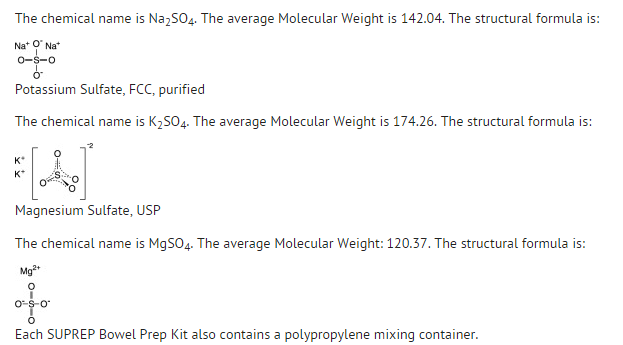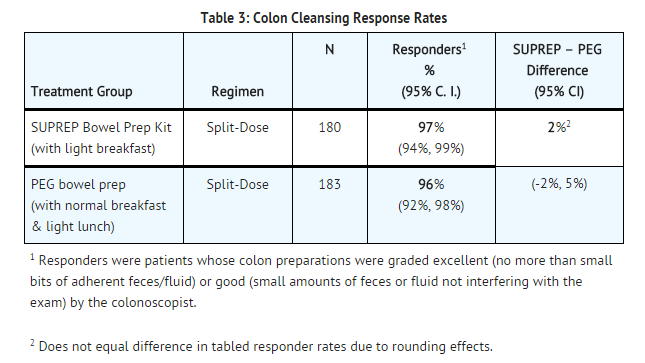Sodium sulfate, potassium sulfate and magnesium sulfate
Editor-In-Chief: C. Michael Gibson, M.S., M.D. [1]; Associate Editor(s)-in-Chief: Ammu Susheela, M.D. [2]
Disclaimer
WikiDoc MAKES NO GUARANTEE OF VALIDITY. WikiDoc is not a professional health care provider, nor is it a suitable replacement for a licensed healthcare provider. WikiDoc is intended to be an educational tool, not a tool for any form of healthcare delivery. The educational content on WikiDoc drug pages is based upon the FDA package insert, National Library of Medicine content and practice guidelines / consensus statements. WikiDoc does not promote the administration of any medication or device that is not consistent with its labeling. Please read our full disclaimer here.
Overview
Sodium sulfate, potassium sulfate and magnesium sulfate is a laxative that is FDA approved for the treatment of for cleansing of the colon as a preparation for colonoscopy in adults. Common adverse reactions include atrioventricular block, hyperbilirubinemia.
Adult Indications and Dosage
FDA-Labeled Indications and Dosage (Adult)
- Sodium sulfate, potassium sulfate and magnesium sulfate solution is indicated for cleansing of the colon as a preparation for colonoscopy in adults.
- Sodium sulfate, potassium sulfate and magnesium sulfate solution should be taken as a split-dose oral regimen.
- The dose for colon cleansing requires administration of two bottles of sodium sulfate, potassium sulfate and magnesium sulfate solution. Each bottle is administered as 16 ounces of diluted SUPREP solution with an additional 1 quart of water taken orally. The total volume of liquid required for colon cleansing (using two bottles) is 3 quarts (approximately 2.8 L) taken orally prior to the colonoscopy in the following way:
Split-Dose (Two-Day) Regimen
Day prior to colonoscopy
- A light breakfast may be consumed, or have only clear liquids on the day before colonoscopy. Avoid red and purple liquids, milk, and alcoholic beverages.
- Early in the evening prior to colonoscopy
- Pour the contents of one bottle of sodium sulfate, potassium sulfate and magnesium sulfate solution into the mixing container provided. Fill the container with water to the 16 ounce fill line, and drink the entire amount.
- Drink two additional containers filled to the 16 ounce line with water over the next hour.
Day of colonoscopy
- Have only clear liquids until after the colonoscopy. Avoid red and purple liquids, milk, and alcoholic beverages.
- The morning of colonoscopy (10 to 12 hours after the evening dose)
- Pour the contents of the second bottle of sodium sulfate, potassium sulfate and magnesium sulfate solution kit into the mixing container provided. Fill the container with water to the 16 ounce fill line, and drink the entire amount.
Drink two additional containers filled to the 16 ounce line with water over the next hour.
- Complete all Sodium sulfate, potassium sulfate and magnesium sulfate solution and required water at least two hours prior to colonoscopy or as directed by physician.
Off-Label Use and Dosage (Adult)
Guideline-Supported Use
There is limited information regarding Off-Label Guideline-Supported Use of Sodium sulfate, potassium sulfate and magnesium sulfate in adult patients.
Non–Guideline-Supported Use
There is limited information regarding Off-Label Non–Guideline-Supported Use of Sodium sulfate, potassium sulfate and magnesium sulfate in adult patients.
Pediatric Indications and Dosage
FDA-Labeled Indications and Dosage (Pediatric)
There is limited information regarding Sodium sulfate, potassium sulfate and magnesium sulfate FDA-Labeled Indications and Dosage (Pediatric) in the drug label.
Off-Label Use and Dosage (Pediatric)
Guideline-Supported Use
There is limited information regarding Off-Label Guideline-Supported Use of Sodium sulfate, potassium sulfate and magnesium sulfate in pediatric patients.
Non–Guideline-Supported Use
There is limited information regarding Off-Label Non–Guideline-Supported Use of Sodium sulfate, potassium sulfate and magnesium sulfate in pediatric patients.
Contraindications
Gastrointestinal obstruction
- Bowel perforation
- Gastric retention
- Ileus
- Toxic colitis or toxic megacolon
- Known allergies to components of the kit
Warnings
Serious Fluid and Serum Chemistry Abnormalities
- Advise all patients to hydrate adequately before, during, and after the use of Sodium sulfate, potassium sulfate and magnesium sulfate solution. If a patient develops significant vomiting or signs of dehydration after taking sodium sulfate, potassium sulfate and magnesium sulfate solution, consider performing post-colonoscopy lab tests (electrolytes, creatinine, and BUN). Fluid and electrolyte disturbances can lead to serious adverse events including cardiac arrhythmias, seizures and renal impairment.
- Patients with electrolyte abnormalities should have them corrected before treatment with sodium sulfate, potassium sulfate and magnesium sulfate solution. In addition, use caution when prescribing sodium sulfate, potassium sulfate and magnesium sulfate solution for patients with conditions, or who are using medications, that increase the risk for fluid and electrolyte disturbances or may increase the risk of adverse events of seizure, arrhythmias, and renal impairment.
- Sodium sulfate, potassium sulfate and magnesium sulfate solution can cause temporary elevations in uric acid. Uric acid fluctuations in patients with gout may precipitate an acute flare. The potential for uric acid elevation should be considered before administering sodium sulfate, potassium sulfate and magnesium sulfate solution to patients with gout or other disorders of uric acid metabolism.
Cardiac Arrhythmias
- There have been rare reports of serious arrhythmias associated with the use of ionic osmotic laxative products for bowel preparation. Use caution when prescribing sodium sulfate, potassium sulfate and magnesium sulfate solution for patients at increased risk of arrhythmias (e.g., patients with a history of prolonged QT, uncontrolled arrhythmias, recent myocardial infarction, unstable angina, congestive heart failure, or cardiomyopathy). Pre-dose and post-colonoscopy ECGs should be considered in patients at increased risk of serious cardiac arrhythmias.
Seizures
- There have been reports of generalized tonic-clonic seizures and/or loss of consciousness associated with use of bowel preparation products in patients with no prior history of seizures. The seizure cases were associated with electrolyte abnormalities (e.g., hyponatremia, hypokalemia, hypocalcemia, and hypomagnesemia) and low serum osmolality. The neurologic abnormalities resolved with correction of fluid and electrolyte abnormalities.
- Use caution when prescribing sodium sulfate, potassium sulfate and magnesium sulfate solution for patients with a history of seizures and in patients at increased risk of seizure, such as patients taking medications that lower the seizure threshold (e.g., tricyclic antidepressants), patients withdrawing from alcohol or benzodiazepines, or patients with known or suspected hyponatremia.
Renal Impairment
- Use caution when prescribing sodium sulfate, potassium sulfate and magnesium sulfate solution for patients with impaired renal function or patients taking concomitant medications that may affect renal function (such as diuretics, angiotensin converting enzyme inhibitors, angiotensin receptor blockers, or non-steroidal anti-inflammatory drugs). Advise these patients of the importance of adequate hydration, and consider performing baseline and post-colonoscopy laboratory tests (electrolytes, creatinine, and BUN) in these patients.
Colonic Mucosal Ulcerations and Ischemic Colitis
- Administration of osmotic laxative products may produce colonic mucosal aphthous ulcerations, and there have been reports of more serious cases of ischemic colitis requiring hospitalization. Concurrent use of stimulant laxatives and sodium sulfate, potassium sulfate and magnesium sulfate solution may increase these risks. The potential for mucosal ulcerations resulting from the bowel preparation should be considered when interpreting colonoscopy findings in patients with known or suspect inflammatory bowel disease (IBD).
Use in Patients with Significant Gastrointestinal Disease
- If gastrointestinal obstruction or perforation is suspected, perform appropriate diagnostic studies to rule out these conditions before administering sodium sulfate, potassium sulfate and magnesium sulfate solution.
- Use with caution in patients with severe active ulcerative colitis.
Aspiration
- Use with caution in patients with impaired gag reflex and patients prone to regurgitation or aspiration. Such patients should be observed during administration of sodium sulfate, potassium sulfate and magnesium sulfate solution solution.
Not for Direct Ingestion
- Each bottle must be diluted with water to a final volume of 16 ounces and ingestion of additional water as recommended is important to patient tolerance. Direct ingestion of the undiluted solution may increase the risk of nausea, vomiting, dehydration, and electrolyte disturbances.
Adverse Reactions
Clinical Trials Experience
Clinical Studies Experience
- Because clinical studies are conducted under widely varying conditions, adverse reaction rates observed in the clinical studies of a drug cannot be directly compared to rates in clinical studies of another drug and may not reflect the rates observed in practice.
- In a multicenter, controlled clinical trial comparing sodium sulfate, potassium sulfate and magnesium sulfate solution with a bowel prep containing polyethylene glycol and electrolytes (PEG + E) that were administered in a split-dose (2-day) regimen, the most common adverse reactions after administration of sodium sulfate, potassium sulfate and magnesium sulfate solution were overall discomfort, abdominal distention, abdominal pain, nausea, vomiting, and headache; see TABLE 1, below. Less common Adverse Reactions occurring were AV Block (1 case) and CK increase. In this study, patients receiving sodium sulfate, potassium sulfate and magnesium sulfate solution were limited to a light breakfast followed by clear liquids; patients receiving the PEG + E bowel prep were allowed to have a normal breakfast and a light lunch, followed by clear liquids.
TABLE 2 shows the percentages of patients who developed new abnormalities of important electrolytes and uric acid after completing the bowel preparation with either sodium sulfate, potassium sulfate and magnesium sulfate solution or PEG+E administered as a split-dose (2-day) regimen.
- Percent (n/N) of patients where N=number of patients with normal baseline who had abnormal values at the timepoint(s) of interest.
†Patients with normal bicarbonate at baseline who developed low bicarbonate (≤ 21 mEq/L) and high anion gap (≥ 13 mEq/L) on Day of Colonoscopy or Day 30.
- There were also 408 patients who participated in a study in which either sodium sulfate, potassium sulfate and magnesium sulfate solution or PEG+E were administered in an evening-only (1-day) regimen. Higher rates of overall discomfort, abdominal distention, and nausea were observed with the evening-only (1-day) regimen compared to the split-dose (2-day) regimen for both preparations. Patients treated with sodium sulfate, potassium sulfate and magnesium sulfate solution had increased rates of vomiting with the evening-only (1-day) regimen.
- An evening-only (1-day) dosing regimen was associated with higher rates of abnormal values for some electrolytes when compared to the split-dose (2-day) regimen for both preparations. For sodium sulfate, potassium sulfate and magnesium sulfate solution, the evening-only (1-day) regimen was associated with higher rates of total bilirubin (high), BUN (high), creatinine (high), osmolality (high), potassium (high) and uric acid (high) than the sodium sulfate, potassium sulfate and magnesium sulfate solution split-dose (2-day) regimen. Administration of sodium sulfate, potassium sulfate and magnesium sulfate solution in an evening-only (1-day) dosing regimen is not recommended.
Postmarketing Experience
Drug Interactions
Drugs That May Increase Risks Due to Fluid and Electrolyte Abnormalities
Use caution when prescribing sodium sulfate, potassium sulfate and magnesium sulfate solution for patients with conditions, or who are using medications, that increase the risk for fluid and electrolyte disturbances or may increase the risk of adverse events of seizure, arrhythmias, and prolonged QT in the setting of fluid and electrolyte abnormalities. Consider additional patient evaluations as appropriate in patients taking these concomitant medications.
Potential for Altered Drug Absorption
- Oral medication administered within one hour of the start of each sodium sulfate, potassium sulfate and magnesium sulfate solution dose may be flushed from the gastrointestinal tract, and the medication may not be absorbed properly.
Use in Specific Populations
Pregnancy
- Animal reproduction studies have not been conducted with sodium sulfate, potassium sulfate and magnesium sulfate solution. It is also not known whether sodium sulfate, potassium sulfate and magnesium sulfate solution can cause fetal harm when administered to a pregnant woman or can affect reproduction capacity. sodium sulfate, potassium sulfate and magnesium sulfate solution should be given to a pregnant woman only if clearly needed.
Pregnancy Category (AUS):
There is no Australian Drug Evaluation Committee (ADEC) guidance on usage of Sodium sulfate, potassium sulfate and magnesium sulfate in women who are pregnant.
Labor and Delivery
There is no FDA guidance on use of Sodium sulfate, potassium sulfate and magnesium sulfate during labor and delivery.
Nursing Mothers
- It is not known whether this drug is excreted in human milk. Because many drugs are excreted in human milk, caution should be exercised when sodium sulfate, potassium sulfate and magnesium sulfate solution is administered to a nursing woman.
Pediatric Use
There is no FDA guidance on the use of Sodium sulfate, potassium sulfate and magnesium sulfate with respect to pediatric patients.
Geriatic Use
- Of the 375 patients who received sodium sulfate, potassium sulfate and magnesium sulfate solution in clinical trials, 94 (25%) were 65 years of age or older, and 25 (7%) were 75 years of age or older.
- No overall differences in safety or effectiveness of sodium sulfate, potassium sulfate and magnesium sulfate solution administered as a split-dose (2-day) regimen were observed between geriatric patients and younger patients.
- Geriatric patients reported more vomiting when sodium sulfate, potassium sulfate and magnesium sulfate solution was given as a one-day preparation.
Gender
There is no FDA guidance on the use of Sodium sulfate, potassium sulfate and magnesium sulfate with respect to specific gender populations.
Race
There is no FDA guidance on the use of Sodium sulfate, potassium sulfate and magnesium sulfate with respect to specific racial populations.
Renal Impairment
There is no FDA guidance on the use of Sodium sulfate, potassium sulfate and magnesium sulfate in patients with renal impairment.
Hepatic Impairment
There is no FDA guidance on the use of Sodium sulfate, potassium sulfate and magnesium sulfate in patients with hepatic impairment.
Females of Reproductive Potential and Males
There is no FDA guidance on the use of Sodium sulfate, potassium sulfate and magnesium sulfate in women of reproductive potentials and males.
Immunocompromised Patients
There is no FDA guidance one the use of Sodium sulfate, potassium sulfate and magnesium sulfate in patients who are immunocompromised.
Administration and Monitoring
Administration
- Intravenous
Monitoring
There is limited information regarding Monitoring of Sodium sulfate, potassium sulfate and magnesium sulfate in the drug label.
IV Compatibility
There is limited information regarding IV Compatibility of Sodium sulfate, potassium sulfate and magnesium sulfate in the drug label.
Overdosage
There is limited information regarding Sodium sulfate, potassium sulfate and magnesium sulfate overdosage. If you suspect drug poisoning or overdose, please contact the National Poison Help hotline (1-800-222-1222) immediately.
Pharmacology
There is limited information regarding Sodium sulfate, potassium sulfate and magnesium sulfate Pharmacology in the drug label.
Mechanism of Action
- Sulfate salts provide sulfate anions, which are poorly absorbed. The osmotic effect of unabsorbed sulfate anions and the associated cations causes water to be retained within the gastrointestinal tract.
Structure
- Each sodium sulfate, potassium sulfate and magnesium sulfate solution contains two 6 ounce bottles of solution. Each 6 ounce bottle contains: sodium sulfate 17.5 grams, potassium sulfate 3.13 grams, magnesium sulfate 1.6 grams. Inactive ingredients include: sodium benzoate, NF, sucralose, malic acid FCC, citric acid USP, flavoring ingredients, purified water, USP. The solution is a clear to slightly hazy liquid. The solution is clear and colorless when diluted to a final volume of 16 ounces with water.
Sodium Sulfate, USP
Pharmacodynamics
- The osmotic effect of the unabsorbed ions, when ingested with a large volume of water, produces a copious watery diarrhea.
Pharmacokinetics
- Fecal excretion was the primary route of sulfate elimination. After administration of sodium sulfate, potassium sulfate and magnesium sulfate solution in six healthy volunteers, the time at which serum sulfate reached its highest point (Tmax) was approximately 17 hours after the first half dose or approximately 5 hours after the second dose, and then declined with a half-life of 8.5 hours.
- The disposition of sulfate after sodium sulfate, potassium sulfate and magnesium sulfate solution was also studied in patients (N=6) with mild-moderate hepatic impairment (Child-Pugh grades A and B) and in patients (N=6) with moderate renal impairment (creatinine clearance of 30 to 49 mL/min). The renal impairment group had the highest serum sulfate AUC and Cmax, followed by the hepatic impairment group, and then by healthy subjects. Systemic exposure of serum sulfate (AUC and Cmax) was similar between healthy subjects and hepatic impairment patients. Renal impairment resulted in 54% higher mean AUC and 44% higher mean Cmax than healthy subjects. The mean sulfate levels of all three groups returned to their respective baseline levels by Day 6 after dose initiation. Urinary excretion of sulfate over 30 hours, starting after the first half dose, was similar between hepatic patients and normal volunteers, but was approximately 16% lower in moderate renal impairment patients than in healthy volunteers.
Nonclinical Toxicology
Carcinogenesis, Mutagenesis, Impairment of Fertility
- Long-term studies in animals have not been performed to evaluate the carcinogenic potential of sodium sulfate, potassium sulfate and magnesium sulfate solution. Studies to evaluate the possible impairment of fertility or mutagenic potential of sodium sulfate, potassium sulfate and magnesium sulfate solution have not been performed.
Animal Toxicology and/or Pharmacology
- The sulfate salts of sodium, potassium, and magnesium contained in sodium sulfate, potassium sulfate and magnesium sulfate solution were administered orally (gavage) to rats and dogs up to 28 days up to a maximum daily dose of 5 grams/kg/day (approximately 0.9 and 3 times for rats and dogs, respectively, the recommended human dose of 44 grams/day or 0.89 grams/kg based on the body surface area). In rats, the sulfate salts caused diarrhea and electrolyte and metabolic changes, including hypochloremia, hypokalemia, hyponatremia, lower serum osmolality, and high serum bicarbonate.
- Significant renal changes included increased fractional sodium excretion, increased urinary sodium and potassium excretion, and alkaline urine in both males and females. In addition, creatinine clearance was significantly decreased in females at the highest dose. No microscopic renal changes were seen. In dogs, the sulfate salts caused emesis, excessive salivation, excessive drinking of water, and abnormal excreta (soft and/or mucoid feces and/or diarrhea) and increased urine pH and sodium excretion.
Clinical Studies
The colon cleansing efficacy of sodium sulfate, potassium sulfate and magnesium sulfate solution was evaluated in a randomized, single-blind, active-controlled, multicenter study. In this study, 363 adult patients were included in the efficacy analysis. Patients ranged in age from 20 to 84 years (mean age 55 years) and 54% were female. Race distribution was 86% Caucasian, 9% African-American, and 5% other.
Patients were randomized to one of the following two colon preparation regimens: sodium sulfate, potassium sulfate and magnesium sulfate solution or a marketed polyethylene glycol (PEG) bowel prep. In the study sodium sulfate, potassium sulfate and magnesium sulfate solution was administered according to a split-dose preparation regimen. The PEG bowel prep was also given as a split-dose preparation according to its labeled instructions. Patients receiving sodium sulfate, potassium sulfate and magnesium sulfate solution were limited to a light breakfast followed by clear liquids on the day prior to the day of colonoscopy; patients receiving the PEG bowel prep were allowed to have a normal breakfast and a light lunch, followed by clear liquids.
The primary efficacy endpoint was the proportion of patients with successful colon cleansing as assessed by the colonoscopists, who were not informed about the type of preparation received. In the study, no clinically or statistically significant differences were seen between the group treated with sodium sulfate, potassium sulfate and magnesium sulfate solution and the group treated with the PEG bowel prep. See TABLE 3 below.
How Supplied
- Each sodium sulfate, potassium sulfate and magnesium sulfate solution contains:
- Two (2) 6 ounce bottles of oral solution.
- One (1) 19 ounce mixing container with a 16 ounce fill line.
Storage
- Store at 20° to 25°C (68° to 77°F). Excursions permitted between 15° to 30°C (59° to 86°F). See USP controlled room temperature.
- Keep out of reach of children.
- Sodium sulfate, potassium sulfate and magnesium sulfate solution NDC 52268-012-01
Images
Drug Images
{{#ask: Page Name::Sodium sulfate, potassium sulfate and magnesium sulfate |?Pill Name |?Drug Name |?Pill Ingred |?Pill Imprint |?Pill Dosage |?Pill Color |?Pill Shape |?Pill Size (mm) |?Pill Scoring |?NDC |?Drug Author |format=template |template=DrugPageImages |mainlabel=- |sort=Pill Name }}
Package and Label Display Panel
{{#ask: Label Page::Sodium sulfate, potassium sulfate and magnesium sulfate |?Label Name |format=template |template=DrugLabelImages |mainlabel=- |sort=Label Page }}
Patient Counseling Information
- Ask patients to let you know if they have trouble swallowing or are prone to regurgitation or aspiration.
- Instruct patients that each bottle needs to be diluted in water before ingestion and that they need to drink additional water according to the instructions. Direct ingestion of the undiluted solution may increase the risk of nausea, vomiting, and dehydration.
- Inform patients that oral medications may not be absorbed properly if they are taken within one hour of starting each dose of sodium sulfate, potassium sulfate and magnesium sulfate solution.
- Tell patients not to take other laxatives while they are taking sodium sulfate, potassium sulfate and magnesium sulfate solution
Precautions with Alcohol
- Alcohol-Sodium sulfate, potassium sulfate and magnesium sulfate interaction has not been established. Talk to your doctor about the effects of taking alcohol with this medication.
Brand Names
- SUPREP BOWEL PREP®[1]
Look-Alike Drug Names
- A® — B®[2]
Drug Shortage Status
Price
References
The contents of this FDA label are provided by the National Library of Medicine.
- ↑ "sodium sulfate, potassium sulfate and magnesium sulfate solution, concentrate".
- ↑ "http://www.ismp.org". External link in
|title=(help)
{{#subobject:
|Label Page=Sodium sulfate, potassium sulfate and magnesium sulfate |Label Name=Sodium sulphate 6.jpg
}}
{{#subobject:
|Label Page=Sodium sulfate, potassium sulfate and magnesium sulfate |Label Name=Sodium sulphate 01.jpg
}}
{{#subobject:
|Label Page=Sodium sulfate, potassium sulfate and magnesium sulfate |Label Name=DailyMed - SUPREP BOWEL PREP- sodium sulfate, potassium sulfate and magnesium sulfate solution, concentrate (1).png
}}



